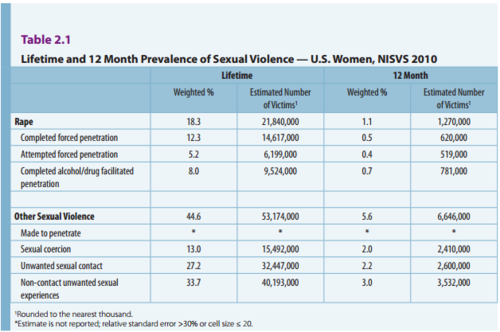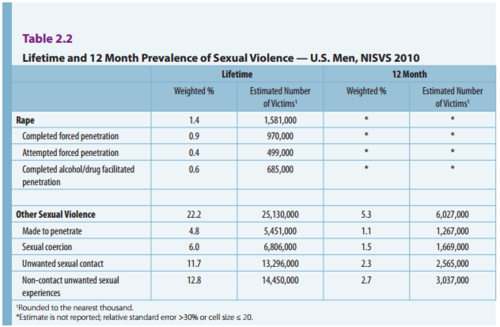In my last post, I discussed the findings "National Intimate Partner and Sexual Violence Survey" (NISVS 2010). I compared the figures on rape and sexual violence for men and women over the 12 months previous to the survey, and I promised I'd get back to why I was using the 12-month figures rather than the lifetime figures (which were the figures significantly more emphasized by the CDC in the introduction and press releases and so forth).
Here are the referenced tables from pages 18 and 19, respectively:


I emphasized in my last post that the numbers of men and women raped (if the arbitrary designation of "made to penetrate" for men is taken from the Not Rape category of "Other Sexual Violence" and properly considered rape) were basically equal, when looking at the 12-month figures. However, some of you will have noticed that there is a giant discrepancy. Even taking into account the rape/Not Rape issue, 4.8 + 1.4 = 6.2% for men over their lifetimes, while women reported 18.3%. That's roughly three times higher. Either 2010 was a really rough year for guys, or there's something else going on here.
Typhonblue of genderratic.com explains it for the Good Man Project:
Researchers into the field of traumatic memory recovery note that the longer the period of time a person is asked recall a traumatic event, the less likely they are to remember it. How this works is that surveys that ask about a traumatic event in the last six months get less false negatives than those that ask about a traumatic event in the last twelve months which, itself, gets considerably fewer false negatives than lifetime prevalence.The short version? Women recall and/or report past sexual trauma four times more often than men. Therefore, surveys of past sexual trauma of men in particular will be extremely inaccurate. So remember that the next time a woman accuses a man of not knowing what it's like to be raped or sexually assaulted. There's actually a much greater chance than you think that he knows exactly what she's talking about; he just doesn't call it rape, because, in our (rape) culture, women don't rape men.
For men this effect is even more pronounced.
16% of men with documented cases of sexual abuse considered their early childhood experiences sexual abuse, compared with 64% of women with documented cases of sexual abuse. These gender differences may reflect inadequate measurement techniques or an unwillingness on the part of men to disclose this information (Widom and Morris 1997).Only 16% of men with documented case histories of child sexual abuse disclosed that abuse on a survey intended to capture child sexual abuse. Sixteen percent of men compared to sixty-four percent of women.
That amounts to a disclosure rate of child sexual abuse four times higher in women than in men.
Is it any wonder that the CDC’s 2010 survey (correcting for their mis-categorization of female-on-male rape) found that 18.3% of women and 6.2% of men were victimized over their lifetimes?
Comparing the lifetime rate of sexual abuse for men and women is misleading in determining their relative risk of sexual violence, simply because men disclose childhood sexual abuse four times less often than women.
There may be many reasons for this. It’s unlikely that it’s due to sexual abuse being less impactful on men because studies have shown that sexual abuse does have a profound impact on men, and this includes female-on-male sexual abuse. For instance, the link between sexual abuse and suicide attempts is stronger in boys (Rhodes et al. 2001) and sexually abused boys are twice as likely to commit suicide (Molnar et al. 2001) than sexually abused girls. In addition to that, there is a risk factor for sexually abused men to sexually abuse others is if their abuser was female (Salter et al. 2003.)
One possible reason for men not disclosing, or even “forgetting”, is quite simple: our social narrative does not allow for, nor does it depict, the sexual abuse of males. To a degree it allows for the sexual abuse of boys by men, but not boys by women or adult men by anyone.
In a study on the effects of retention interval and gender on the perception of violence, Ahola et al. (2009) found that eyewitnesses rated female perpetrators less violent than male when reporting after an interval of one to three weeks as opposed to ten minutes. Ahola et al. (2009) proposed that over time eyewitnesses reinterpreted the behavior of perpetrators in order to conform to gender stereotypes regarding violence.
Widom and Morris (1997) propose that a similar process is occurring with male victims of sexual abuse (particularly by females) as, over time, they reinterpret their victimization to conform with the dominant social narrative regarding sexual abuse: that it happens to women and is perpetrated by men. They will do this by reframing their abuse as consensual or as a rite of passage or less violent than it was or by “forgetting” it completely. The more time passes, the more our memories conform to the dominant social narrative.
Gender differences in reporting and in perceptions of early childhood experiences may reflect early socialization experiences in which men learn to view these behaviors as non-predatory and non-abusive. Many of the sexual experiences considered to be sexual abuse (showing/touching sex organs, kissing in a sexual way) may be seen as developmental rites of passage, part of a learning process (Widom and Morris 1997.)Note that this “forgetting” does not mean that there is no psychological effect; only that the source of that effect is buried, becoming a silent trigger for self-destructive behavior.
No comments:
Post a Comment